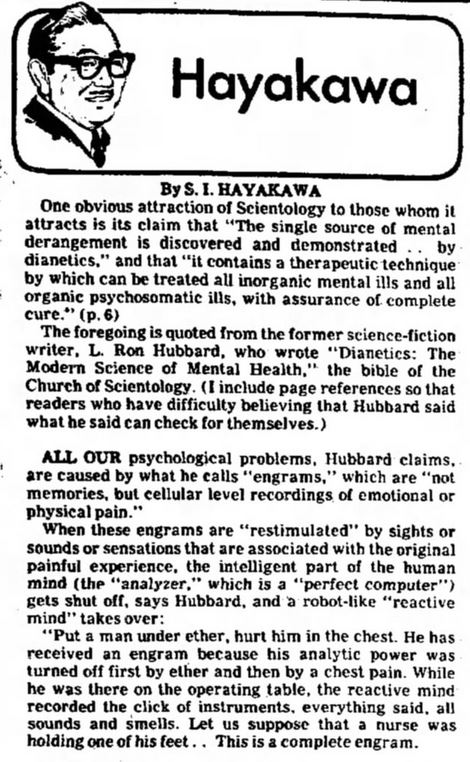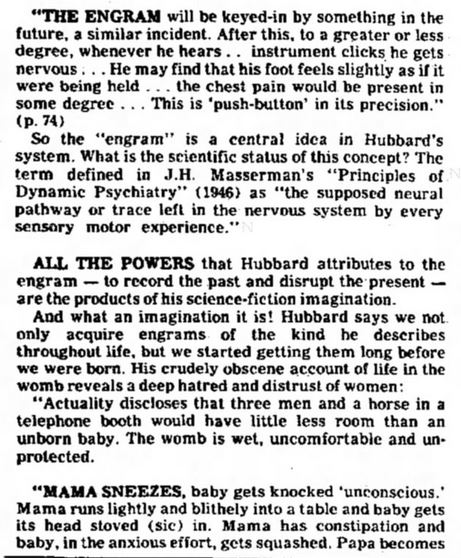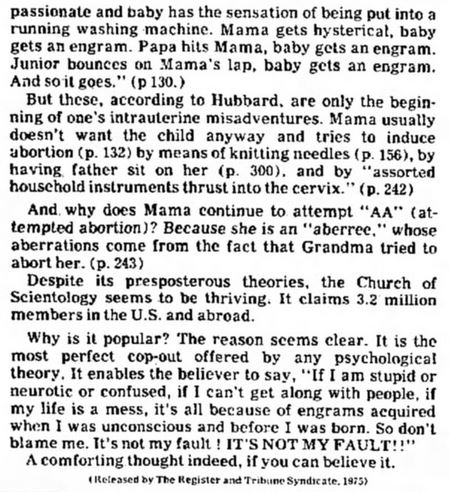Our London publisher, Humfrey Hunter of Silvertail Books, submitted our book about Paulette Cooper, The Unbreakable Miss Lovely, to Kirkus Reviews. And…
Hey! They like it.
Whew. That’s a relief. Kirkus is very important in the publishing industry, and it doesn’t hurt to have a good review as Silvertail continues to promote the book. Here’s what Kirkus has to say…
Ortega, in his nonfiction debut, describes a journalist’s decadeslong battle against the Church of Scientology. There have been assertions of horror stories involving the Church of Scientology in a plethora of books, articles, documentaries, and interviews with ex-members. This new account focuses on Paulette Cooper, one of the first journalists to investigate what many see as the questionable moral practices of L. Ron Hubbard’s religion—and one of the first people, he says, to become a target of its vengeance. In a 1969 article in Queen magazine and later in a 1971 book, The Scandal of Scientology, Cooper offered a damning exploration of the church and its practices. “More than previous writers,” notes Ortega, “Paulette focused on the harassment of those who dared to speak up about Scientology, whether they’d been in the church or not.” In response to her words, Ortega says, the church set out to destroy her life with an unprecedented yearslong campaign of litigation, defamation, intimidation, and harassment that pushed the journalist nearly to the point of suicide. In Cooper, Ortega finds the perfect foil to what he portrays as the secretive, suppressive machinations of Scientology: she’s a nearly archetypical newshound, savvy and scoop-obsessed, with a colorful history of committing fully to her work. For example, Ortega shares one anecdote of Cooper stowing away on a cruise ship for the sake of a travel piece, hiding in plain sight and stashing a change of clothes in a barroom piano. This book is far from just another look into the familiar, if terrifying, alleged tactics of the Church of Scientology; it’s a profile of a fascinating reporter making her bones and taking her lumps in the fickle world of 1970s magazine journalism. Plucky, self-possessed, and fearless in the face of the many threats–legal and otherwise–against her reputation and person, Cooper is a figure whose name is worth knowing. A thrilling account of a reporter’s duel with a controversial church.
We also want to thank our readers who have posted reviews at Amazon. It’s a pleasure to see how people have reacted to Paulette’s amazing life story.
——————–
S.I. Hayakawa’s later shot at Scientology
Yesterday, Jon Atack reminded us that in 1951, California English professor and General Semantics promoter S.I. Hayakawa wrote a devastating takedown of L. Ron Hubbard’s book Dianetics in an academic journal.
In 1975, writing a nationally syndicated column the year before he ran for US Senate, Hayakawa recycled his earlier review with some updated observations for a brief piece that ran in many newspapers. We managed to track down a copy that appeared in the El Paso Herald-Post on January 21, 1975…
Hayakawa’s column also ran in the San Francisco Examiner on January 18, 1975, and Scientology struck back with a full page ad in the Stanford Daily several months later.
SCIENTOLOGY: AN OPEN LETTER TO S.I. HAYAKAWA & THE S.F. EXAMINER
AS MEMBERS OF THE CHURCH OF SCIENTOLOGY we are appalled at the publication (1/18/75) of a defamatory editorial on Scientology by Mr S. I. Hayakawa without subsequent publication of any of the many replies to that editorial sent to the Examiner from Scientologists. Over the years, many articles critical of Scientology have appeared in the media, while supporters of the church have rarely been able to get their views aired. Since the early 50’s, the American Medical Association, the American Psychiatric Association and the World Federation of Mental Health have conducted campaigns. both overt and covert, to discredit and outlaw Scientology. The details of this campaign are available in the book The Hidden Story of Scientology written by (non-Scientologist) Omar Garrison. Why should these groups single out Scientology for attack? The answer is that Scientology is more of a threat to them than are other churches, and this tor several reasons: (1) Scientology’s pastoral counselling techniques are effective in a way that neither psychiatric treatment nor other religious therapies are, in that results are uniformly and predictably good. (2) Scientology is actively engaged in stamping out psychiatric abuses such as indiscriminate use of electroconvulsive “therapy” and psychosurgery (see FREEDOM, the journal of the Church of Scientology). (3) Scientology is the largest religion involved in spiritual/mental healing, now comprising many millions of members. The number of Scientologists with practical knowledge of its pastoral counselling techniques is far greater than the number of psychiatrists. (4) Scientology is the fastest-growing religion in the world. The result of this campaign has been that we can learn almost nothing about Scientology or Dianetics through the mass media. It appears that at one time in the past, “Authorities” encouraged the publication of some derogatory articles, and every uninformed writer since then has become a link in a closed but expanding chain of ignorant “Authorities,” each one citing the opinions of others as “fact,” and none taking the trouble to examine first hand the subject they condemn with such vitriol. People need accurate information about Scientology. It can no longer be considered an “obscure cult” but must be classed as one of the world’s major religions, in the best tradition of those spiritual disciplines that have sought to free individuals from suffering and bring them to a state of spiritual enlightenment. For that reason, we are taking it upon ourselves to reprint significant portions of Mr. Hayakawa’s article, “Dianetics: Escape from responsibility,” together with three letters in response to it that the Examiner did not print.
The ad then contained three responses to Hayakawa’s article. We figured you’d want to see them as well.
LET ME START BY ACKNOWLEDGING A DEBT of long standing. My early discovery of (your book) Language, Thought and Action had an excellent effect on my subsequent career in philosophy. I still regard the fundamentals of semantics not as clever debating points for a beginning class in English, but as principles of a true philosophy of science . . . So I am a little disturbed by your column . . . which seems to take a polemical attitude, rather than one of objective observation. Your key point against Hubbard seems to be the doubtful scientific status of J. H Masserman’s “engram.” In contrast, Hubbard’s own (more recent) definition of the term depends on the hypothesis of a section of the human mind that “thinks in pictures,” by mechanisms of associative memory. An “engram” is then a mental picture of a past incident (“memory” has not quite the right connotations) containing pain and unconsciousness. Hubbard chose the word “engram” for this technical concept at a time (1950) when he was speculating that storage of such mental pictures might occur chemically in the human body. (None of Hubbard’s psychological theories . . . depends on a particular physical storage method for these pictures.) Hubbard’s claims for his psychology of mental pictures are curiously operational, and objectively testable; in this respect he differs from most theorists of human psyche . . . Hubbard’s philosophy of science is distinctly phenomenological, in the best traditions of Edmund Husserl in Europe, and philosophical Buddhism in Asia. Personally, I have not found Scientology to provide a psychological copout. In fact, Hubbard claims that ALL mental problems, and ALL problems in life, originate with a denial of responsibility! The required therapy is thus a gentle but accelerating encouragement of the subject to re-own his own mind, and be fully responsible for all its contents and activities. In short, I am guessing that were you to investigate Hubbard and Scientology more completely, with that perfect scientific skepticism which is so rare, even among those who are supposedly trained in it, you would find much to agree with I find it ironic that one who has so much in common with Hubbard should ridicule him publicly; even more so that a master of semantics should quote a 25-year old speculation out of context and use A s definition of B’s technical term as an argument against B’s theory! If you and I must agree to disagree (as civilized men will, rather than hate each other) then let it be amicably Hubbard has publicly admired “cocky little Hayakawa.” Could you af least do him the courtesy of taking him seriously? Yours truly, Lewis E. Randall
Dear Dr. Hayakawa YESTERDAY OR THE DAY BEFORE you should have received a letter from Mr. Lewis Randall . . Lewis is an old friend of mine, a classmate at Harvard (’64), and was the first person to introduce me to the admittedly unlikely sounding school of thought based on the work of Mr. Hubbard, “the former science fiction writer.” Like Mr. Randall, I am a person who has felt and come to appreciate your own influence in my life: I received my Master’s in Early Childhood Education at San Francisco State during your tenure there I wish that I could tell you honestly . . . that I respected you and your actions there at the time, I cannot. My own awareness of . . . personal responsibility was sufficiently dim in those days that in fact I condemned you. That to have done so was wrong, and a reflection not on your actions but upon my own irresponsibility, was an insight which I came upon only, in fact, after a considerable degree of exposure to Scientology. I have long since come to applaud your courage and the high sense of personal ethics which you demonstrated at San Francisco State. Again like Mr. Randall, I find myself wholly unable to applaud the quality of your efforts on the subject of Mr. Hubbard. I suspect that you would dismiss out of hand any Article about yourself which contained reference to “the former bedwetter, S. I. Hayakawa.” Certainly I would tend to do so. Why, then, the appearance of the argument ad hominem in your own article? In castigating Hubbard entirely in the absence of evidence based on your own experience, you assume the guise of the myriad hacks who have done the same before you. By virtue both of your work and your convictions, your place is not among them. The guise fits you ill. I realize that the pressures inherent in writing for a deadline may have seemed to preclude the possibility of genuine investigation into the subject of Scientology — of the sort that would normally be required by yourself, of yourself, as a matter of principle. Nonetheless (and I confess that I quote Hubbard), “the environment starts to control the individual the moment he rationalizes away his inherent full responsibility.” In allowing the pressure of a deadline to affect your better judgment, it seems clear to me that you have not acted in this matter as responsibly as you might have. I would welcome the opportunity to present to you in person a somewhat different viewpoint on Hubbard/Dianetics/Scientology than the one you hold at present You and I met briefly one evening same time ago . . . and my recollection of that occasion leads me to suspect that we would both enjoy making each other’s reacquaintance. In any case, I am Respectfully yours, Gerald D. French
Dear Mr. Hayakawa, AS A PSYCHIATRIST AND A SCIENTOLOGIST, I have had a unique opportunity to observe and compare the effects of traditional psychotherapies and Scientologic techniques, in my own hands and in those of others. Scientology and Dianetic techniques work better and faster than any other techniques I have observed in relieving human suffering and increasing ability without creating either a sense of dependency on the therapist or a tendency to copout and blame others for one’s troubles. If you talk to a person who has . . . (received Scientology counselling), you will observe a highly responsible and causative individual. I would like to deal further with the issue of the psychotherapeutic copout. Any theory that attempts to explain human behavior by means of fixed mechanical laws of cause and effect has the potential liability of becoming a copout such as you describe. Freud thought that all aspects of mental behavior were completely determined by childhood experiences; the behaviorist believes that all behavior is the inevitable result of present external stimuli acting on patterns established by past conditioning. So why single out Scientology for vituperation in this respect? In fact, Scientology, since the early ’50s, has stressed the fact that each person is entirely responsible for his own condition in life. Present day misfortunes are brought on oneself in an effort to justify past harmful acts against others. No explanation of personal misfortune in terms of implacable outside forces would ever satisfy a present-day Scientologist. A reflection of this philosophy is the fact that in modern Dianetics, equal weight is given to the . . . (examination of incidents in which) an individual has caused others to have painful experiences, Contained in the idea of complete personal responsibility is the assumption that an individual has the power to change the conditions of his life, in spite of apparent social, physical, or mechanical impediments to doing so. If this power exists, then a person must in some way be an unmoved mover, with the ability to transcend any mere mechanical cause-and-effect forces of existence. Such an unmoved mover could only be described as a non-mechanical or non-material entity, or, in other words, as a spiritual being. It is for this reason and not to appear mysterious or to hide under the mantle of religiosity that Scientology describes itself as a religion. It is a religion, in the tradition of all spiritual disciplines whose intention is to eliminate human suffering, both physical and mental, and to restore to individuals their full freedom and native abilities. (It) is the mark of a truly responsible person — which I believe you basically to be — that when he finds new data, he alters his point of view to accommodate the data. I urge you to investigate Scientology more fully. Talk to a few Scientologists. Perhaps read a few of the more recent Scientology publications. If you do this, you will, I think, find that there is a great deal of agreement between your views and those of Mr Hubbard. Yours truly, Frank A Gerbode III, M.D
We find that Gerbode left Scientology in 1982 and four years later was interviewed by Jon Atack (we have come full circle). In Jon’s 1990 book, A Piece of Blue Sky, Gerbode makes this appearance…
In his ruling in the Armstrong suit in California, Judge Breckenridge called Hubbard “schizophrenic,” but was he really insane? Avoiding the sometimes contradictory definitions of psychiatric authorities, it seems safe to take the legal view that a madman is someone who cannot be considered responsible for his actions. He suffers from delusions, and has no clear sense of right and wrong. Psychiatrist Frank Gerbode, who practiced Scientology for many years, feels that Hubbard was not schizophrenic, but rather “manic with paranoid tendencies” (which is not a classification of psychosis, but of tendencies towards psychosis). However, Gerbode suggests that the best description is the lay diagnosis “loony.”
After leaving Scientology, Gerbode and Gerald French explored their own version of abreactive therapy that they termed Traumatic Incident Reduction. In a 2012 comment on Marty Rathbun’s blog, Mike Rinder said that while he was Scientology’s spokesman he worked with Gerbode as he was publishing a book about TIR “to ensure his book didn’t infringe on church intellectual property rights.” Rinder claimed that Gerbode and TIR were still more “aligned” to L. Ron Hubbard than to the church itself.
But we figure Hubbard still would have called them squirrels.
Isn’t this fun?
——————–
 Posted by Tony Ortega on January 9, 2016 at 07:00
Posted by Tony Ortega on January 9, 2016 at 07:00
E-mail tips and story ideas to tonyo94 AT gmail DOT com or follow us on Twitter. We post behind-the-scenes updates at our Facebook author page. After every new story we send out an alert to our e-mail list and our FB page.
Our book, The Unbreakable Miss Lovely: How the Church of Scientology tried to destroy Paulette Cooper, is on sale at Amazon in paperback and Kindle editions. We’ve posted photographs of Paulette and scenes from her life at a separate location. Reader Sookie put together a complete index. More information about the book, and our 2015 book tour, can also be found at the book’s dedicated page.
Learn about Scientology with our numerous series with experts…
BLOGGING DIANETICS: We read Scientology’s founding text cover to cover with the help of L.A. attorney and former church member Vance Woodward
UP THE BRIDGE: Claire Headley and Bruce Hines train us as Scientologists
GETTING OUR ETHICS IN: Jefferson Hawkins explains Scientology’s system of justice
SCIENTOLOGY MYTHBUSTING: Historian Jon Atack discusses key Scientology concepts
Other links: The Lisa McPherson story told in real time | The Cathriona White stories | The Leah Remini ‘Knowledge Reports’ | Hear audio of a Scientology excommunication | Scientology’s little day care of horrors | Whatever happened to Steve Fishman? | Felony charges for Scientology’s drug rehab scam | PZ Myers reads L. Ron Hubbard’s “A History of Man” | Scientology’s Master Spies | Scientology’s Private Dancer | The mystery of the richest Scientologist and his wayward sons | Scientology’s shocking mistreatment of the mentally ill | Scientology boasts about assistance from Google | The Underground Bunker’s Official Theme Song | The Underground Bunker FAQ
Our Guide to Alex Gibney’s film ‘Going Clear,’ and our pages about its principal figures…
Jason Beghe | Tom DeVocht | Sara Goldberg | Paul Haggis | Mark “Marty” Rathbun | Mike Rinder | Spanky Taylor | Hana Whitfield










